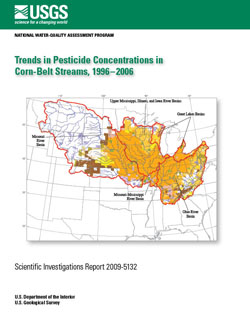Scientific Investigations Report 2009-5132
ABSTRACT
Trends in the concentrations of commonly occurring pesticides in the Corn Belt of the United States were assessed, and the performance and application of several statistical methods for trend analysis were evaluated. Trends in the concentrations of 11 pesticides with sufficient data for trend assessment were assessed at up to 31 stream sites for two time periods: 1996–2002 and 2000–2006. Pesticides included in the trend analyses were atrazine, acetochlor, metolachlor, alachlor, cyanazine, EPTC, simazine, metribuzin, prometon, chlorpyrifos, and diazinon. The statistical methods applied and compared were (1) a modified version of the nonparametric seasonal Kendall test (SEAKEN), (2) a modified version of the Regional Kendall test, (3) a parametric regression model with seasonal wave (SEAWAVE), and (4) a version of SEAWAVE with adjustment for streamflow (SEAWAVE-Q). The SEAKEN test is a statistical hypothesis test for detecting monotonic trends in seasonal time-series data such as pesticide concentrations at a particular site. Trends across a region, represented by multiple sites, were evaluated using the regional seasonal Kendall test, which computes a test for an overall trend within a region by computing a score for each season at each site and adding the scores to compute the total for the region. The SEAWAVE model is a parametric regression model specifically designed for analyzing seasonal variability and trends in pesticide concentrations. The SEAWAVE-Q model accounts for the effect of changing flow conditions in order to separate changes caused by hydrologic trends from changes caused by other factors, such as pesticide use. There was broad, general agreement between unadjusted trends (no adjustment for streamflow effects) identified by the SEAKEN and SEAWAVE methods, including the regional seasonal Kendall test. Only about 10 percent of the paired comparisons between SEAKEN and SEAWAVE indicated a difference in the direction of trend, and none of these had differences significant at the 10-percent significance level. This consistency of results supports the validity and robustness of all three approaches as trend analysis tools. The SEAWAVE method is favored, however, because it has less restrictive data requirements, enabling analysis for more site/pesticide combinations, and can incorporate adjustment for streamflow (SEAWAVE-Q) with substantially fewer measurements than the flow-adjustment procedure used with SEAKEN. Analysis of flow-adjusted trends is preferable to analysis of non-adjusted trends for evaluating potential effects of changes in pesticide use or management practices because flow-adjusted trends account for the influence of flow-related variability. Analysis of flow-adjusted trends by SEAWAVE-Q showed that all of the pesticides assessed, except simazine and acetochlor, were dominated by varying degrees of concentration downtrends in one or both analysis periods. Atrazine, metolachlor, alachlor, cyanazine, EPTC, and metribuzin—all major corn herbicides, as well as prometon and chlorpyrifos, showed more prevalent concentration downtrends during 1996–2002 compared to 2000–2006. Diazinon had no clear trends during 1996–2002, but had predominantly downward trends during 2000–2006. Acetochlor trends were mixed during 1996–2002 and slightly upward during 2000–2006, but most of the trends were not statistically significant. Simazine concentrations trended upward at most sites during both 1996–2002 and 2000–2006. Comparison of concentration trends to agricultural-use trends indicated similarity in direction and magnitude for acetochlor, metolachlor, alachlor, cyanazine, EPTC, and metribuzin. Concentration downtrends for atrazine, chlorpyrifos, and diazinon were steeper than agricultural-use downtrends at some sites, indicating the possibility that agricultural management practices may have increasingly reduced transport to streams (particularly atrazine) or, for chlorpyrifos and diazinon, that nonagricultural uses declined substantially. Concentration uptrends for simazine generally were steeper than agricultural-use uptrends, indicating the possibility that nonagricultural uses of this herbicide increased during the study period. |
For additional information contact: Part or all of this report is presented in Portable Document Format (PDF); the latest version of Adobe Reader or similar software is required to view it. Download the latest version of Adobe Reader, free of charge. |
Sullivan, D.J., Vecchia, A.V., Lorenz, D.L., Gilliom, R.J., and Martin, J.D., 2009, Trends in pesticide concentrations in corn-belt streams, 1996–2006: U.S. Geological Survey Scientific Investigations Report 2009–5132, 75 p.
Abstract
Introduction
Purpose and Scope
Study Design and Method
Use and Properties of Pesticides
Trends in Pesticide Concentrations
Conclusions
References Cited
Appendixes